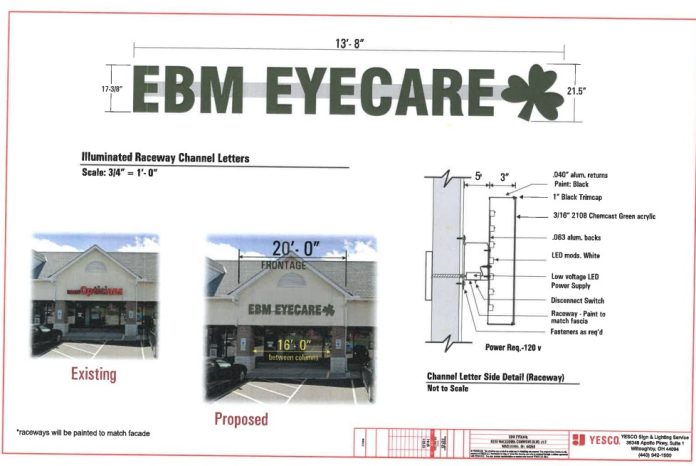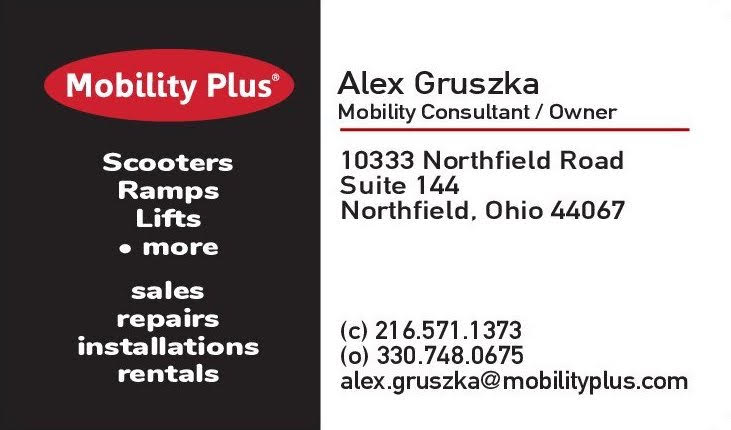The Macedonia Planning Commission met September 15 to review several business sign applications and discuss proposed changes to residential driveway requirements.
Business Signage Approvals
The commission approved signage for ProQuip at 850 East Highland Road after the applicant made requested modifications. The revised proposal included a brick base matching the building and added landscaping around the sign base. Commission members requested additional year-round shrubs to complement the proposed perennials.
The commission also approved green signage for EBM Eye Care at Macedonia Commons after the applicant addressed technical requirements including sign height and trim specifications. EBM Eye Care is taking over unit 52, previously occupied by Paris Opticians. The green color was added to the approved shopping center color palette.
ATM Application Continued
An application from Optimus Solutions to install a First National Bank ATM at Macedonia Commons was continued to the October meeting due to the applicant’s absence. The ATM would be installed on an existing concrete island in the shopping plaza parking lot, replacing a Chase Bank ATM that was previously removed from the same location.
City planner Brian Frantz noted concerns about the proposed ATM’s aesthetics and excessive signage height that would need to be addressed when the applicant returns.
Property Split Discussion
The commission reviewed a proposed lot split for the Enclave at Macedonia apartment complex, where Davey Tree Resource Group, acting as surveyor for the property owner, requested to split a 2.1-acre parcel. The Enclave development is owned and operated by Redwood, a property management company.
According to city planner Brian Frantz’s memo, while the stated purpose is for a neighboring property owner to expand his yard area for himself and his dogs, the split is presumably being done in preparation for Redwood to request additional apartment development sites in the future.
Commission members expressed concerns about creating a non-buildable lot that might later be used to seek variances. The property is largely within the riparian setback along Indian Creek, limiting development potential.
The item was continued to October to allow for deed restrictions protecting the city from future variance requests and to clarify the neighbor’s specific intentions for the property. The commission wants to ensure the lot split doesn’t become a pathway for future development that circumvents normal zoning requirements.
Heated Driveway Ordinance Debate
The commission engaged in extensive discussion about proposed ordinance 51-2025, which would require hard-surface driveways for residential properties. The proposal originated from the building department’s concerns about maintenance and aesthetics of gravel driveways.
The ordinance would require concrete or bituminous concrete driveways from the street to primary residences and to any accessory buildings sized for vehicle storage. However, commission members identified several problematic issues with the language.
Legal Concerns Raised
Commission member Tony Cox, who has legal experience, raised significant concerns about the ordinance’s enforceability. He cited Ohio Revised Code Section 713.15, which protects legal non-conforming uses, stating that “lawful use of any building as existing at the time of enacting a zoning ordinance may be continued.”
Cox argued that homeowners with existing gravel driveways dating back decades could invoke this protection. He was particularly concerned about the word “repaired” in the ordinance, noting that simply adding gravel to maintain an existing driveway could trigger the requirement for full concrete replacement under the proposed language.
Comparison to Other Communities
Cox distributed examples from North Olmsted and Sheffield Lake showing how other communities handle similar ordinances. These examples included specific grandfathering language to protect existing driveways while requiring new construction to meet updated standards.
Specific Issues Identified
The commission identified several problems with the current draft:
- The word “repair” was too vague and could force expensive upgrades for routine maintenance
- No clear grandfathering provisions for existing driveways
- Potential hardship for residents who have maintained gravel driveways for 50+ years
- Unclear enforcement mechanisms
Building Department Input
Building Commissioner Monaco explained that gravel driveways are becoming wider and less maintained, creating aesthetic and practical problems. The department wants hard surfaces from the road to garages, but acknowledged that requiring paved paths to distant outbuildings on large lots could be expensive and impractical.
Commission’s Decision
Rather than act on the flawed ordinance, the commission decided to:
- Request City Council withdraw ordinance 51-2025
- Schedule a work session to rewrite the language properly
- Involve the law department in drafting legally sound provisions
- Study successful ordinances from other communities
Commission members agreed the concept has merit but needs significant revision to address legal concerns and practical implementation issues.
Cox’s Departure
The lengthy debate was among the final contributions from Tony Cox, who announced this would likely be his last meeting after serving 12-15 years on the commission. Cox had previously asked the commission to find a replacement for him, marking the end of a long tenure during which he brought legal expertise to planning decisions.
Chairman Westbrooks thanked Cox for his years of service and contributions to the commission, expressing hope that he might stay for one more month. Cox was invited to attend the October meeting even if no longer serving officially, particularly for the driveway ordinance work session where his legal background would be valuable.
Cox advocated for proper legal review rather than “creating something out of our heads” – a philosophy that characterized his approach throughout his tenure on the commission.

























